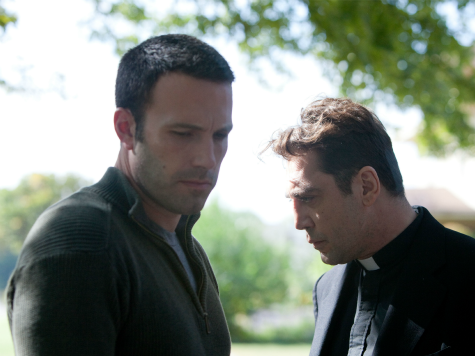
The opening of Terrence Malick’s To the Wonder sees a couple, an American man and a French woman (Ben Affleck and Olga Kurylenko), intoxicated in love whilst twirling through Paris.
They take a trip to Le Mont St. Michel, an architectural marvel of a commune, where whether or not you can walk to there depends entirely on the tide. It lushly illustrates how exhilarating it is to fall in love, how the world seems as spiritually sacred and private as a monastery housing you. But eventually the tide rolls in, and the true test of faith and devotion sets in.
The man takes his French lover (and her daughter from a previous relationship) back to Texas with him. It’s a wild change of setting, going from the old buildings of Europe to the cookie-cutter communities of middle America, where love settles down and the real world sets in.
But Malick doesn’t look down his nose at suburbia the way Hollywood often tends to do. He finds beauty and poetry in the Americana settings of fast-food drive-ins and open fields dotted with oil derricks, the same way he does on shores as stunning as those of Mont St. Michel.
To the Wonder is about the tide of the relationship between Affleck’s silent male, and Kurylenko’s spiritual female, the latter of which has become something of an archetype in Malick’s last few films. We saw this sort of woman hinted at in the warm flashbacks of The Thin Red Line, before she became the focus of his work in The New World with Q’orianka Kilcher’s portrayal of Pocahontas.
But beginning with Tree of Life, Malick’s work has become increasingly self-reflective. Malick, who himself lost a brother to suicide, meditated on childhood and loss in Tree of Life, and in To the Wonder, Affleck’s character seems to be a surrogate for Malick himself and his relationships with women.
After the film’s dizzy prologue, his character always seems present in his scenes, but the focus is always on Kurylenko, her emotions telegraphed via Malick’s trademark poetic voiceover. Affleck’s performance is emotionally distant, and everything we learn about who he is comes from the women in his life, be it Kurylenko’s character, or a rancher (Rachel McAdams) he strikes up a relationship with when he and the French woman temporarily part ways.
A curious sub-plot in the film involves Javier Bardem as a Catholic priest, a portion of the film that has little to do with the main narrative, at least on the surface. This character is often seen tending to his flock, especially the less-fortunate side of the community, while occasionally dealing with the social side of his parish out of necessity, but with a look of boredom.
People often ask why Catholic priests are not allowed to marry, and To the Wonder might be the first film I’ve seen that indirectly answers that question. Being a priest, and tending to the needs of those in the Church, couldn’t even be described as a full-time job, because to do so would suggest that there is at least some down time.
To be a priest is to be devoted to the spiritual needs of your parish community, the way being a husband is to be devoted to the needs of your wife and children. Having obligations in both arenas is problematic, as one area is sure to end up neglected.
The juxtaposition of the trials of a man and a woman, versus the trials of a priest and his flock is a powerful one. A man and a woman can always walk away from each other, whereas a priest does not have that option, as we see Bardem’s character selflessly give himself to his community.
Malick’s work has become more and more threadbare with each passing film, further eschewing dramatic narrative in favor of visual poetry. This obviously makes his later films annoying for some, but with every movie he makes, it’s hard to dispute that he seems more defined as an artist with To the Wonder than ever before. His increasingly prolific output seems to have ended the long honeymoon he’s had with the critics, a community is oh-so-susceptible to mystique, but To the Wonder is the sort of movie he’s always made at its bones. He’s simply stripping away at it, further removing aesthetic grandiosity in the form of lavish period settings, moving his work closer and closer to God.

COMMENTS
Please let us know if you're having issues with commenting.